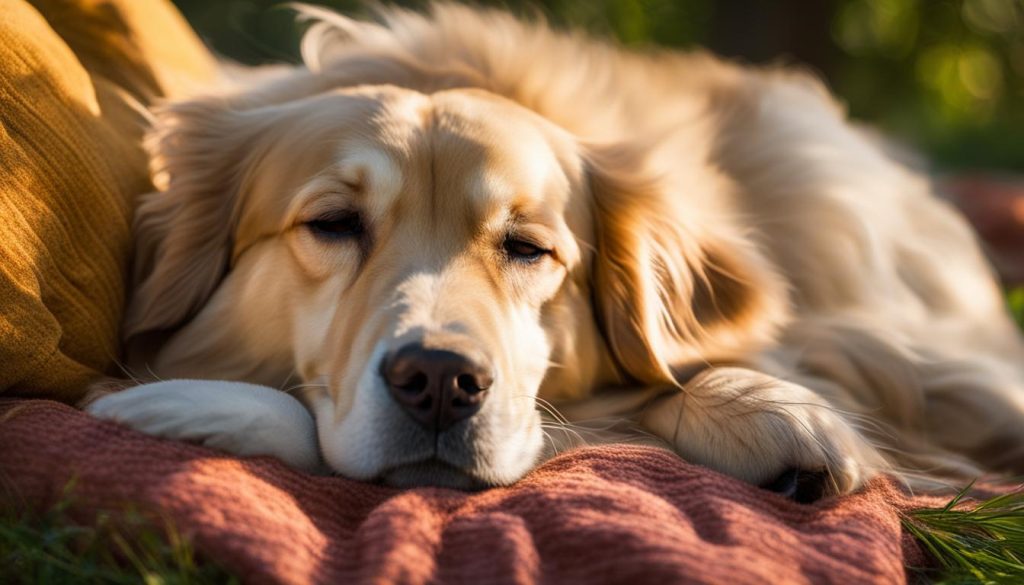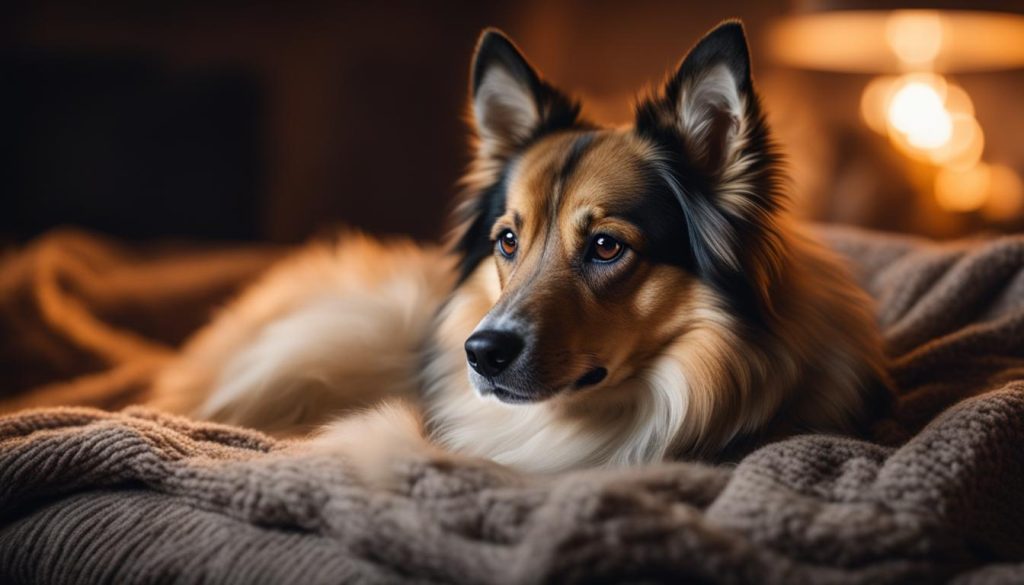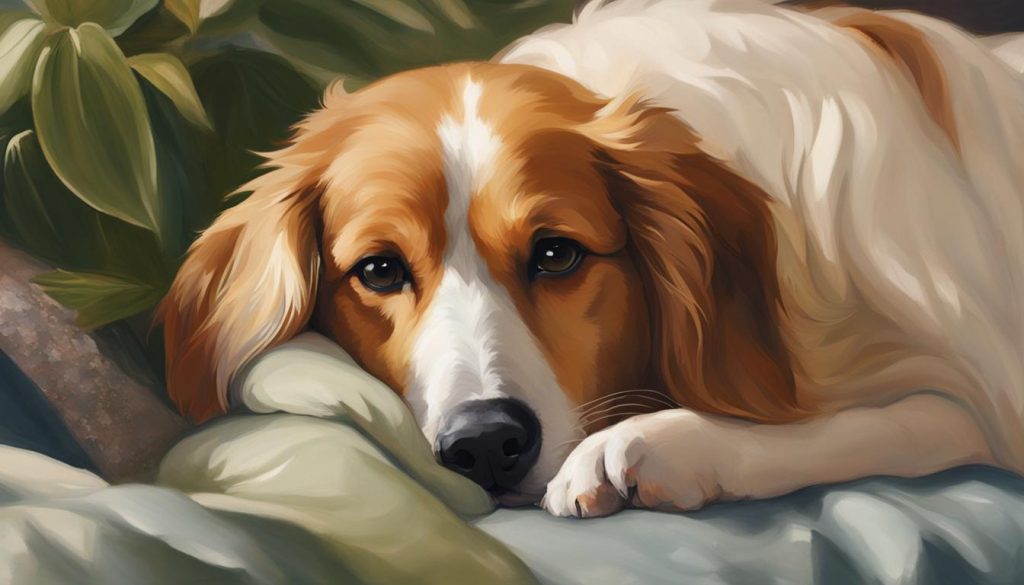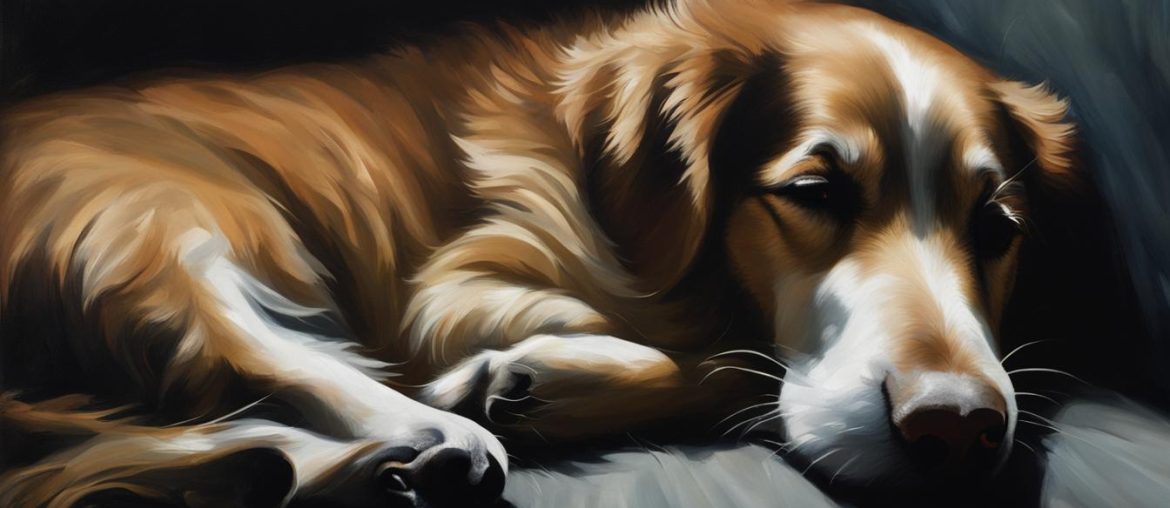Dogs are fascinating creatures, and their sleep habits can be quite intriguing. One common question that often arises is whether dogs sleep with their eyes open. While it may seem unusual, dogs do sometimes sleep with their eyes open, and this behavior can have several explanations.
There are a few theories as to why dogs engage in this behavior. It could be that they are not fully asleep and are still partially aware of their surroundings. This would allow them to stay alert even while resting. Another possibility is that it is an instinctual behavior inherited from their wild ancestors, enabling them to be on the lookout for potential threats. Additionally, dogs may sleep with their eyes open during REM sleep, the stage of sleep associated with dreams.
While occasional eye-opening during sleep is generally considered normal, if a dog consistently sleeps with their eyes open or shows other abnormal sleep behaviors, it may indicate an underlying medical condition that should be evaluated by a veterinarian.
Key Takeaways:
- Dogs sometimes sleep with their eyes open, which can be a normal occurrence.
- This behavior may be due to the dog not being fully asleep or their instinct to stay alert while resting.
- Sleeping with their eyes open during REM sleep is also a possibility.
- If a dog consistently sleeps with their eyes open or shows abnormal sleep behaviors, veterinary evaluation is recommended.
- Understanding a dog’s sleep patterns and behaviors can help ensure their overall well-being.
Why Do Dogs Sleep With Their Eyes Open?

One of the intriguing behaviors exhibited by dogs is sleeping with their eyes open. Although the exact reason for this behavior is not fully understood, several theories have been proposed. One theory suggests that dogs are not completely asleep when their eyes are open, but rather in a state of deep relaxation where they remain partially aware of their surroundings. It is thought that this allows them to quickly respond to any potential threats or stimuli. Another theory proposes that sleeping with eyes open is an instinctual behavior that originated from their wild ancestors, enabling them to stay alert and vigilant even while resting.
Dogs may also sleep with their eyes open during the rapid eye movement (REM) sleep stage, which is associated with dreaming. REM sleep is characterized by increased brain activity and muscle relaxation, and dogs may exhibit movements, including eye movements and twitching, during this stage.
While sleeping with their eyes open can be considered normal in certain circumstances, consistent or unusual sleep behaviors should not be ignored. If a dog consistently sleeps with their eyes open or displays other abnormal sleeping patterns, it could be an indication of an underlying medical condition. In such cases, it is advisable to consult a veterinarian for a thorough examination and appropriate guidance.
| Possible Reasons for Dogs Sleeping with Their Eyes Open | |
|---|---|
| 1. Partial awareness during deep relaxation. | |
| 2. Instinctual behavior to stay alert and vigilant. | |
| 3. Sleeping with eyes open during REM sleep. |
“Dogs sleeping with their eyes open can be a normal occurrence, but if it is accompanied by other abnormal sleep behaviors, it is advisable to seek veterinary attention.”
Understanding Canine Sleep Habits
Canine sleep patterns are similar to those of humans, including the presence of different sleep stages. Dogs experience slow-wave sleep, which is a state of deep relaxation, and REM sleep, which is associated with dreaming. These sleep stages play an important role in a dog’s overall well-being and help them restore physical and mental health.
By understanding the reasons behind dogs sleeping with their eyes open, pet owners can better appreciate their furry companions’ unique sleep habits. However, it is essential to remain vigilant and attentive to any changes in sleep behavior to ensure the health and happiness of our beloved dogs.
Sleep-Related Eye Conditions in Dogs
While it’s not uncommon for dogs to sleep with their eyes open, there are instances where this behavior may be linked to underlying eye conditions or disorders. Certain breeds, such as Pugs or Boston Terriers, with short faces and bulging eyes, may be more prone to these conditions. Dogs with eye or eyelid conditions, like cherry eye or lagophthalmos, may also find it difficult to close their eyes normally during sleep. These conditions can prevent the eyes from fully closing, resulting in partially open eyes during sleep.
It’s important to note that if a dog consistently sleeps with their eyes open or displays signs of eye discomfort, it is recommended to consult a veterinarian. They can properly diagnose any underlying eye conditions and provide appropriate treatment. In some cases, surgery may be necessary to alleviate discomfort and prevent further complications. Early detection and intervention are crucial in ensuring the overall well-being of the dog.
| Eye Conditions | Breeds Prone |
|---|---|
| Cherry eye | Pugs, Boston Terriers |
| Lagophthalmos | Various breeds |
Dogs with narcolepsy, a neurological disorder affecting the sleep/wake cycle, may also sleep with their eyes open. Narcolepsy can cause sudden bouts of sleepiness, even during activities, leading to incomplete muscle paralysis and partially open eyes during sleep episodes. If a dog consistently displays abnormal sleep patterns or appears disoriented when waking up, it may be a sign to seek veterinary attention.
Regular veterinary check-ups and attentive monitoring of a dog’s sleep habits can help identify and address any potential eye conditions or sleep-related issues. By understanding the specific needs of our furry companions, we can provide them with the care they require to maintain healthy sleep patterns and overall well-being.
Is It Normal for Dogs to Sleep with Their Eyes Open?

It is generally considered normal for dogs to sleep with their eyes open on occasion, especially during light sleep or when they are in a relaxed state. Dogs have a third eyelid called the nictitating membrane, which helps protect their eyes. This partially clear membrane is visible when dogs sleep with their eyes open, giving the appearance that their eyes are partially open. The nictitating membrane serves to clean and protect the eyes, automatically retracting when the dog opens its eyes fully. This natural eye protection mechanism helps prevent dirt and debris from entering the eyes and keeps them moist. It is a normal part of a dog’s anatomy and should not be a cause for concern.
During sleep, dogs go through different stages, including slow-wave sleep and REM sleep. Slow-wave sleep is a period of deep relaxation where the dog’s heart rate and breathing slow down, and their body relaxes. Dogs may appear to be sleeping with their eyes open during this stage because they are in a state of deep relaxation but not fully unconscious. REM sleep, on the other hand, is the stage where dreaming occurs, and dogs may exhibit movements, including eye movements, twitching, and vocalizations. These behaviors are considered normal and should not be cause for concern.
Dogs sleeping with their eyes open can be attributed to various factors. One theory suggests that dogs are not fully asleep but in a state of deep relaxation, where they have not lost consciousness completely. This may explain why they can quickly return to full awareness if stimulated. Another theory is that this behavior is rooted in their evolutionary instincts to stay alert and be aware of their surroundings even while sleeping. Additionally, dogs may sleep with their eyes open during REM sleep, the stage associated with dreaming. These factors contribute to the normal sleep behavior of dogs.
Table: Comparison of Normal vs. Abnormal Sleeping Behaviors in Dogs
| Normal Sleeping Behaviors | Abnormal Sleeping Behaviors |
|---|---|
| Dog occasionally sleeps with eyes open | Dog consistently sleeps with eyes open |
| Dog appears relaxed and at ease during sleep | Dog shows signs of discomfort or restlessness during sleep |
| Dog exhibits normal sleep patterns and cycles | Dog experiences disruptions in sleep patterns or cycles |
| Dog wakes up refreshed and alert | Dog appears disoriented or confused upon waking |
In most cases, dogs sleeping with their eyes open are not a cause for concern. However, if a dog consistently sleeps with their eyes open or exhibits abnormal behavior or signs of discomfort during sleep, it is recommended to consult a veterinarian for proper evaluation. A veterinarian can help determine if there are any underlying medical conditions or health issues contributing to the abnormal sleeping behaviors and provide appropriate treatment if needed.
Understanding a dog’s sleep patterns and behaviors is crucial for pet owners to ensure their furry friends’ overall well-being. By being aware of what is considered normal and abnormal sleeping behavior in dogs, pet owners can provide the necessary care and seek professional help when needed. Observing and monitoring a dog’s sleep habits can contribute to a happy and healthy canine companion.
When to Be Concerned About Dogs That Sleep With Their Eyes Open
While it is generally considered normal for dogs to sleep with their eyes open on occasion, there are situations where it may be necessary to seek veterinary attention. If your dog consistently sleeps with their eyes open or exhibits abnormal behavior upon waking up from sleep, it could indicate an underlying medical issue or the possibility of a seizure. Other signs to look out for include falling asleep in unusual places or at inappropriate times, red or inflamed eyes, excessive discharge from the eyes, or difficulty walking. If any of these symptoms are present, it is recommended to schedule a checkup with a veterinarian.
In most cases, dogs sleeping with their eyes open are not a cause for concern. However, certain situations may warrant medical attention. It is important to note that dogs with certain eye or eyelid conditions may find it difficult or impossible to close their eyes normally during sleep. Breeds with short faces and bulging eyes, such as Pugs or Boston Terriers, may be more prone to these types of conditions. Additionally, dogs with narcolepsy, a neurological disorder that affects the sleep/wake cycle, may also sleep with their eyes open.
If your dog consistently sleeps with their eyes open or shows other signs of eye discomfort or abnormal sleeping patterns, it is important to consult a veterinarian. They will be able to evaluate your dog’s condition, provide a proper diagnosis, and recommend appropriate treatment if necessary. Early detection and intervention can help prevent further complications and ensure your dog’s overall well-being.
Understanding Dog Sleep Patterns

Understanding the sleep patterns of dogs is crucial for pet owners to ensure their furry friends get the rest they need. Dogs, like humans, go through different stages of sleep, including slow-wave sleep and REM sleep.
During slow-wave sleep, a dog’s heart rate and breathing slow down, and their body relaxes. This is when dogs may appear to be sleeping with their eyes open, as they are in a state of deep relaxation but not fully unconscious.
REM sleep, on the other hand, is the stage where dreaming occurs. During REM sleep, dogs may exhibit movements, including eye movements, twitching, and vocalizations. These behaviors are considered normal and should not be a cause for concern.
Understanding these sleep stages can help pet owners better interpret their dog’s sleep patterns and behaviors. By recognizing the different phases of sleep, owners can ensure their dogs are getting the necessary rest for their overall well-being and quality of life.
Additionally, by observing their dog’s sleep positions, owners can gain insights into their pet’s comfort and preferences during sleep. Some common sleep positions include curled up, on their back, or stretched out. Each position may signify different levels of comfort or the dog’s need to cool down or warm up. However, it’s important to note that individual dogs may have their unique sleep positions, and it’s essential to respect their preferences.
Common Dog Sleep Positions:
- Curled up: This is a common sleep position for dogs and may indicate a desire for warmth and security.
- On their back: Dogs that sleep on their backs are often indicating a feeling of safety and trust in their environment.
- Stretched out: Dogs that sleep stretched out are often trying to cool down and regulate their body temperature.
- Side sleeping: Sleeping on the side may signify comfort and relaxation.
By understanding and respecting their dog’s sleep patterns and positions, pet owners can create a comfortable sleep environment and contribute to their pet’s overall health and well-being.
Eye Protection in Dogs

When it comes to dogs sleeping with their eyes open, it’s important to understand that they have a natural eye protection mechanism called the nictitating membrane. This third eyelid is partly transparent and helps to clean and protect their eyes while they sleep. The nictitating membrane is responsible for keeping the eyes moist and preventing dirt and debris from entering. When a dog sleeps with their eyes open, it’s often because this protective membrane is partially visible, giving the impression that their eyes are not fully closed. However, this is completely normal and should not be a cause for concern.
The nictitating membrane automatically retracts when a dog opens their eyes fully, allowing them to see clearly. It serves as a vital safeguard for their eyes, especially during sleep when they are more vulnerable. This eye protection mechanism is a natural part of a dog’s anatomy and has evolved over time to ensure their eyes stay healthy and well-maintained. So, if you notice your dog sleeping with their eyes open, rest assured that it’s simply their body’s way of providing essential eye protection during sleep.
To sum up, dogs sleeping with their eyes open is a normal occurrence and can be attributed to their nictitating membrane, which functions as a protective barrier while they sleep. If your dog sleeps with their eyes open and shows no signs of discomfort or abnormal behavior, there is no cause for concern. However, if you have any doubts or notice any other unusual symptoms, it’s always a good idea to consult your veterinarian for evaluation and guidance.
Medical Conditions and Sleeping with Eyes Open

While it is normal for dogs to occasionally sleep with their eyes open, consistent or prolonged eye-opening during sleep may indicate an underlying medical condition. Two common conditions that can cause dogs to sleep with their eyes open are cherry eye and lagophthalmos.
| Condition | Explanation |
|---|---|
| Cherry Eye | Cherry eye is a condition in which the tear gland on the third eyelid prolapses, leading to a visible red mass in the corner of the eye. Dogs with cherry eye may have difficulty closing their eyes fully during sleep, resulting in partially open eyes. |
| Lagophthalmos | Lagophthalmos is a condition in which the dog is unable to close its eyelids fully. This can be caused by weak eyelid muscles or other eyelid abnormalities. Dogs with lagophthalmos may sleep with their eyes open as a result of their inability to close them completely. |
If you notice that your dog consistently sleeps with their eyes open or exhibits signs of eye discomfort, such as redness or discharge, it is important to consult a veterinarian. These medical conditions can cause discomfort and may require treatment, including surgical intervention, to alleviate symptoms and prevent complications.
Differentiating Between Dreaming and Seizures
When observing a dog’s sleeping behaviors, it can sometimes be challenging to differentiate between normal dreaming and potential seizures. Both can involve movements, including eye movements, twitching, and vocalizations. However, there are distinct differences that can help pet owners identify and understand what their furry friends may be experiencing.
Normal dreaming during REM sleep is a natural part of a dog’s sleep cycle, and it typically involves gentle movements and sounds. Dogs may appear to be fully immersed in their dreams, with their eyes closed and their bodies relaxed. These dream episodes are generally harmless and should not cause concern.
On the other hand, seizures can be more intense and alarming. During a seizure, a dog may experience violent movements, an inability to wake up or respond to stimuli, and a tense or rigid body. In some cases, a dog may have their eyes fully open during a seizure, maintaining a staring or unfocused gaze. Seizures can be accompanied by other signs of distress, such as drooling, excessive salivation, or loss of bladder or bowel control.
| Dreaming | Seizure | |
|---|---|---|
| Description | Gentle movements, eye movements, and vocalizations during REM sleep | Violent movements, inability to wake up, tense or rigid body |
| Eye appearance | Eyes usually closed | Eyes may be fully open with a staring or unfocused gaze |
| Response to stimuli | Dog can easily wake up or respond to external stimuli | Dog is unresponsive and unaware of their surroundings |
If you suspect that your dog may be having seizures rather than simply dreaming, it is crucial to consult a veterinarian for proper evaluation and guidance. Seizures can be a symptom of an underlying medical condition and should be addressed promptly. A veterinarian will be able to conduct a thorough examination, perform any necessary diagnostic tests, and recommend appropriate treatment options.
Tips for Promoting Healthy Sleep in Dogs
In order to ensure optimal sleep quality for your canine companion, it is important to establish a consistent sleep routine. Dogs thrive on routine, so providing them with a structured sleep schedule can help them relax and sleep better. Here are some tips to promote healthy sleep in dogs:
Create a Comfortable Sleep Environment
Provide your dog with a comfortable and quiet sleep space that is free from distractions. This could be a cozy bed or a crate, depending on your dog’s preferences. Make sure the sleep area is clean, well-ventilated, and at an appropriate temperature to ensure your dog’s comfort.
Exercise and Mental Stimulation
Dogs need regular physical exercise and mental stimulation throughout the day to tire them out and promote better sleep at night. Take your dog for daily walks, play interactive games with them, and provide them with puzzle toys or treat-dispensing toys to keep their minds occupied.
Feed a Balanced Diet
A healthy diet plays a crucial role in a dog’s overall well-being, including their sleep quality. Feed your dog a balanced diet that is appropriate for their age, size, and breed. Avoid feeding them too close to bedtime to prevent digestive issues that can disrupt their sleep.
Avoid Excessive Noise and Disturbances
Dogs are sensitive to noise, so it is important to create a quiet and peaceful sleep environment for them. Avoid exposing them to loud noises or disturbances during their designated sleep time. Consider using white noise machines or calming music to drown out any disruptive sounds.
By following these tips, you can help promote healthy sleep habits in your dog, which is essential for their overall health and well-being. Remember, each dog is unique, so it may take some trial and error to find what works best for your furry friend. If you have any concerns or notice any changes in your dog’s sleep patterns, it is always a good idea to consult with your veterinarian for further guidance.
| Tip | Description |
|---|---|
| Create a Comfortable Sleep Environment | Provide a cozy and quiet sleep space for your dog, such as a comfortable bed or crate. |
| Exercise and Mental Stimulation | Engage your dog in regular physical exercise and provide mental stimulation to tire them out. |
| Feed a Balanced Diet | Ensure your dog’s diet is balanced and appropriate for their age, size, and breed. |
| Avoid Excessive Noise and Disturbances | Create a quiet sleep environment for your dog and minimize exposure to loud noises. |
Seeking Veterinary Care for Sleep-Related Issues

When it comes to dogs sleeping with their eyes open or exhibiting abnormal sleep behaviors, seeking veterinary care is crucial. As a pet owner, it’s important to prioritize your dog’s well-being and ensure that any underlying medical issues causing sleep-related problems are addressed promptly. Consulting a veterinarian not only helps diagnose potential health concerns but also provides appropriate treatment and guidance for your furry friend.
During a veterinary visit, your dog’s sleep patterns and behaviors will be evaluated in order to identify any abnormalities. The veterinarian may conduct further tests, such as bloodwork or imaging, to rule out any underlying medical conditions. Early detection of sleep-related issues can help prevent further complications and ensure your dog’s overall health and well-being.
Remember, dogs rely on us to advocate for their health. If your dog consistently sleeps with their eyes open or displays abnormal sleep behaviors, don’t hesitate to schedule a checkup. Your veterinarian will provide the necessary care and support to help your dog achieve a restful and healthy sleep.
Wrapping Up
To sum up, the sleep behavior of dogs, including sleeping with their eyes open, can vary and may have different explanations. While it is generally considered normal for dogs to occasionally sleep with their eyes open, especially during light sleep or when they are in a relaxed state, consistent eye-opening during sleep or other abnormal sleep behaviors may indicate underlying medical issues.
To ensure the well-being of our furry friends, it is important to observe their sleep patterns and behaviors. If a dog consistently sleeps with their eyes open or exhibits signs of discomfort or abnormal behavior during sleep, it is advisable to consult a veterinarian. They can evaluate any potential underlying medical issues and provide appropriate treatment or further diagnostic tests if necessary.
Understanding a dog’s sleep patterns and behaviors can help us take better care of them during their sleep. By providing a comfortable and quiet sleep environment, regular exercise and mental stimulation, and a balanced diet, we can promote healthy sleep for our canine companions. Seeking veterinary care when needed will help ensure their overall health and well-being during sleep.
FAQ
Do dogs sleep with their eyes open?
Yes, dogs sometimes sleep with their eyes open, which can be a normal occurrence. It is believed that they may be in a state of deep relaxation or exhibiting instinctual behavior to stay alert while sleeping.
Why do dogs sleep with their eyes open?
Dogs may sleep with their eyes open because they are not fully asleep and remain partially aware of their surroundings. It may also be an instinctual behavior that allows them to stay alert while sleeping. Additionally, dogs may sleep with their eyes open during REM sleep, which is the stage of sleep associated with dreaming.
What are some sleep-related eye conditions in dogs?
Dogs with certain eye or eyelid conditions, such as cherry eye or lagophthalmos, may find it difficult to close their eyes fully during sleep, resulting in partially open eyes. Breeds with short faces and bulging eyes may be more prone to these conditions.
Is it normal for dogs to sleep with their eyes open?
Yes, it is generally considered normal for dogs to sleep with their eyes open on occasion, especially during light sleep or when they are in a relaxed state. Dogs may also exhibit other behaviors during sleep, such as twitching or moving their eyes, which are associated with REM sleep.
When should I be concerned about a dog that sleeps with their eyes open?
If a dog consistently sleeps with their eyes open or shows other signs of discomfort or abnormal behavior during sleep, it may be worth consulting a veterinarian. Additionally, if the dog is disoriented upon waking or exhibits symptoms such as falling asleep in unusual places or red/inflamed eyes, veterinary attention is recommended.
What are dog sleep patterns like?
Dogs go through different stages of sleep, including slow-wave sleep and REM sleep. During slow-wave sleep, their heart rate and breathing slow down, and their body relaxes. REM sleep is the stage where dreaming occurs, and dogs may exhibit movements and eye twitching.
Do dogs have any natural eye protection when sleeping?
Yes, dogs have a third eyelid called the nictitating membrane, which partly covers their eyes and helps protect them. It is a normal part of a dog’s anatomy and automatically retracts when the dog opens its eyes fully.
Can medical conditions cause dogs to sleep with their eyes open?
Yes, certain eye or eyelid conditions can cause dogs to sleep with their eyes open. Breeds with short faces and bulging eyes may be more prone to these conditions. Additionally, dogs with narcolepsy or other neurological disorders that affect the sleep/wake cycle may also sleep with their eyes open.
How can I differentiate between dreaming and seizures in dogs?
Dreaming and seizures can sometimes appear similar, but seizures are characterized by more violent movements, an inability to wake the dog, and a tense or rigid body. If there is uncertainty or concern about a dog’s sleeping behaviors, it is best to consult a veterinarian for proper evaluation.
What are some tips for promoting healthy sleep in dogs?
To promote healthy sleep in dogs, it is important to establish a consistent sleep routine, provide a comfortable sleep environment, ensure regular exercise and mental stimulation, and feed a balanced diet. Dogs also benefit from having a designated sleep area where they can feel safe and secure.
When should I seek veterinary care for sleep-related issues in my dog?
If a dog consistently sleeps with their eyes open or exhibits abnormal sleep behaviors, it is recommended to seek veterinary care. A veterinarian can evaluate any underlying medical conditions and provide appropriate treatment. They may also recommend further diagnostic tests to rule out potential health concerns.
What can I conclude about dogs sleeping with their eyes open?
Dogs sleeping with their eyes open can be a normal occurrence, but it is important to monitor their sleep patterns and behaviors. If there are consistent abnormalities or signs of discomfort, consulting a veterinarian is recommended to ensure the dog’s overall health and well-being.






